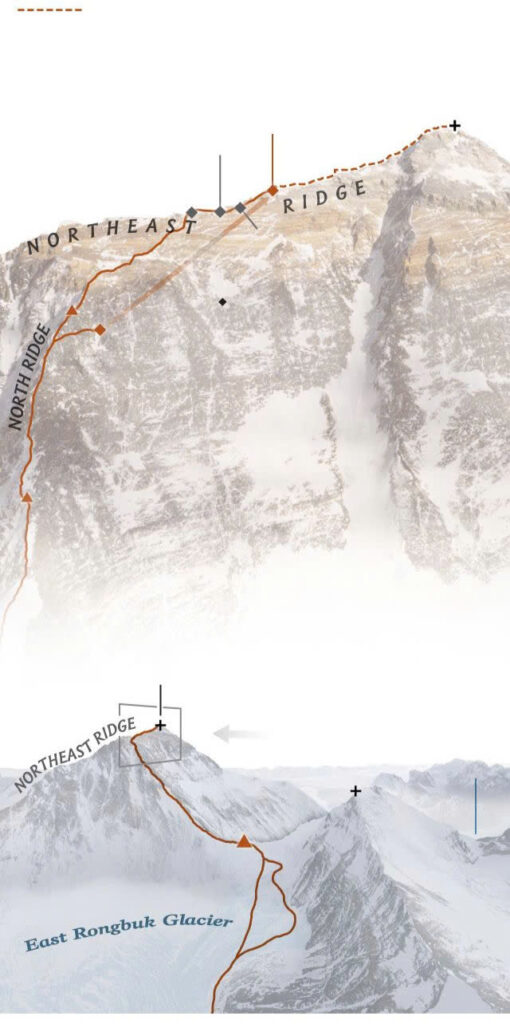The mountaineering world stands in awe after a century-old mystery has finally resurfaced from the icy silence of Mount Everest. The remains of Andrew “Sandy” Irvine — the 22-year-old British climber who vanished alongside George Mallory during their historic 1924 expedition — have been discovered, shedding new light on one of exploration’s most haunting questions: did they reach the summit before anyone else?
The Historic 1924 Expedition

The year was 1924, and the British Empire’s ambition to conquer the world’s highest peak had reached its fever pitch. George Mallory, already a veteran of two previous Everest attempts, set out once again — this time partnered with Sandy Irvine, a promising young Oxford engineer.
Irvine’s mechanical genius made him indispensable to the team, particularly for his innovative work on the expedition’s oxygen apparatus. Though inexperienced in extreme altitude climbing, his calm intellect and unwavering determination earned Mallory’s confidence.
On June 8, 1924, the two men were last seen through binoculars by teammate Noel Odell, ascending the mountain’s upper slopes. Odell described spotting them “moving strongly” toward the summit before clouds swallowed them whole. They never returned.
For the next hundred years, their disappearance remained one of the most enduring mysteries in mountaineering — an unsolved riddle locked in ice.
The Breakthrough Discovery

In September 2024, a century after that fateful climb, the mystery took a dramatic turn. A National Geographic team led by Academy Award–winning filmmaker and mountaineer Jimmy Chin made a discovery that sent shockwaves across the globe.
While traversing the Central Rongbuk Glacier on the north face of Everest, the team spotted what appeared to be the leather toe of an old climbing boot protruding from the ice. Upon closer inspection, they uncovered a partially preserved body still encased in frozen layers of snow and glacial debris.
Stamped on the inside of a weathered sock were the initials “A.C. Irvine.”
It was the breakthrough that generations of climbers and historians had awaited.
Why the Find Matters

Mallory’s body was famously discovered in 1999 by an expedition led by Conrad Anker, but Irvine’s location — and, crucially, his Kodak Vest Pocket camera — had eluded all searches since.
That small camera, if recovered and developed, could hold photographic proof of whether Mallory and Irvine stood atop Everest nearly three decades before Sir Edmund Hillary and Tenzing Norgay’s historic 1953 ascent.
The idea that the two men might have reached the summit before their tragic fall has long divided historians. Now, Irvine’s rediscovery renews hope that the final piece of evidence may one day emerge from the mountain’s depths.
Preserving a Century-Old Moment

Following strict conservation protocols, the discovery site was secured in coordination with the China-Tibet Mountaineering Association. Chin’s team documented the remains in detail, collected limited DNA samples, and ensured that the body was respectfully re-covered by the ice that had guarded it for so long.
Preliminary studies suggest that the body had shifted significantly over time, likely carried downslope by the slow but relentless movement of the glacier. Artifacts found nearby — fragments of rope and a metal buckle — correspond to equipment used on the 1924 expedition.
The team’s footage will form part of an upcoming National Geographic documentary chronicling the century-long search for Irvine and the lasting enigma of Everest’s first great mystery.
The Legacy of Sandy Irvine

Sandy Irvine’s rediscovery is not only a historical milestone but also a deeply human one. At the time of his death, Irvine was just 22 years old — an age when most explorers were still dreaming of adventure, not defining its limits. His ingenuity in designing the team’s oxygen systems, coupled with his youthful resolve, helped make Mallory’s final attempt possible.
For Irvine’s descendants, the discovery brings long-awaited closure. His great-niece, historian Julie Summers, described it as “a moment of immense peace after generations of wondering.”
“Knowing that Sandy has finally been found,” she said, “means his story can rest where it began — on the mountain he loved.”
Did They Reach the Summit?

The question that has haunted mountaineering for a century remains tantalizingly open. Evidence from Mallory’s body — a rope injury around his waist, snow goggles in his pocket suggesting nightfall, and his daughter’s photograph missing from his belongings — hints that they may have reached the summit and died on their descent.
But without Irvine’s camera, the debate endures.
Historians and climbers alike continue to wonder whether, on that clouded afternoon in June 1924, two figures really did stand atop the world — unseen, unrecorded, and unmatched for nearly thirty years.
A Mystery That Endures

Mount Everest, with its allure and danger, has always blurred the line between triumph and tragedy. The rediscovery of Sandy Irvine after a century is not just a recovery of remains but a restoration of legacy — a reminder of the courage, obsession, and sacrifice that defined the earliest age of exploration.
As the ice of Everest slowly releases its secrets, one thing becomes clear: some dreams never die. They simply wait, frozen in time, for the world to find them again.
Sources
- National Geographic – Jimmy Chin’s Team Discovers Remains on Everest
- BBC News – The Mystery of Mallory and Irvine’s Last Climb
- Smithsonian Magazine – Searching for Irvine’s Lost Camera
- The Guardian – Mount Everest’s Oldest Mystery
- Reuters – Scientists Confirm Identity of Remains Found on Everest
